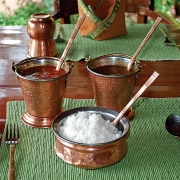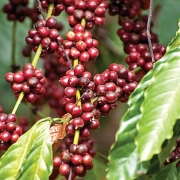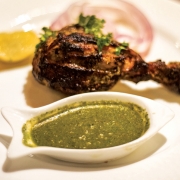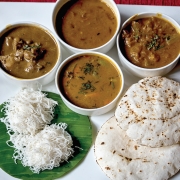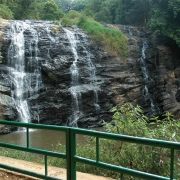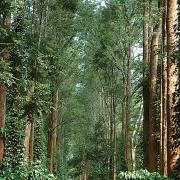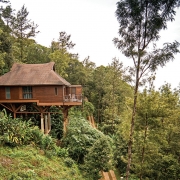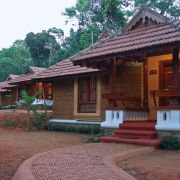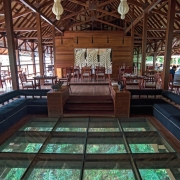
Etcetera
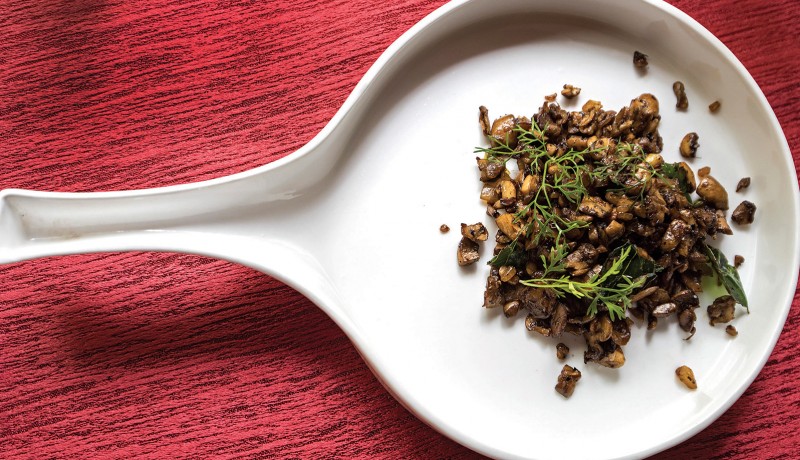
With full-bodied flavours and wild ingredients, the sizzling Coorgi fare is sure to jolt your taste buds
Secrets are not to be revealed. And so, still cloaked in secrecy are the origins of the warrior-like Kodavas or Coorgis—inhabitants of Kodagu, that most alluring district in Karnataka—whose ancestry, culture and cuisine are the focus of endless speculation.
Coorgis are the only community in India allowed to possess a gun without a permit. These handsome people of noble visage and robust build, it is conjectured, are descendants of Alexander the Great’s army. Are they the progeny of stray soldiers who stayed back to live a life of ease in a land of peace and plenty, bordering Kerala? Does the blood of ancient Greeks flow in their veins or were they Kurds who fled Iraq and Islam? There are no conclusive answers to these thorny questions.
The cuisine, too, of these valorous people is muscular and brawny, evoking hot smoky flavours, incorporating ingredients that jolt rather than tickle the taste buds! In the days of yore, these were garnered from the forest—wild boar, venison, fowl, yams, colocasia leaves and mushrooms. The meat was smeared with salt and turmeric and placed on wooden slats or strung from the rafters over a roaring fire as a way to preserve it and impart a smoky flavour to the flesh. These hunks were strung alongside muzzle-loading guns and horns of gunpowder!
Even today, the meat of the goat is dried, then roasted on an open flame, pounded and softened and cooked in spicy gravy. In the 21st century, the seemingly random exotica have bowed out to what is available in a homemaker’s larder; for instance, pork has replaced wild boar in the district’s sizzling curries. Yet, some wild ingredients continue to sneak into dishes like wild bamboo shoot curry or wild mango curry, imparting that inimical tang to the cuisine. While we were told the best Coorgi cuisine is savoured in a local home or at a wedding, our curiosity and insatiable appetite had us gorging on this tantalising local fare during a halcyon stay in Coorg.
Our resort, Tamara Coorg, located 10 km away from the historic Nalknad Palace, snuggles within 180.2 acre of a lush organic coffee and spice plantation, and is surrounded by a tangled, waterfall-streaked forest. Tamara Coorg echoes the wilderness aura of Coorg itself, where lush farmlands merge into forested slopes and rolling coffee estates. And in its restaurant, cantilevered over a waterfall, with a wrap-around veranda to boot, Coorgi cuisine did a martial tap dance on our taste buds, seeming to draw colour and heft from its robust past.
This is a cuisine that is not doused in spices but allows the unique, fresh seasonal produce that goes into it have its say! Topping the list of ingredients is rice, a selection of meats and vegetables cooked in gingelly or sesame oil in gleaming copper vessels. At one time, the wealth of the Kodavas was gauged in glistening green paddy fields and horns of cattle. But nocturnal raids on paddy by wild boar prompted the owners to shoot the invaders and eat them. This is how the famous staple, pandi curry or wild boar curry, evolved; it is a rich, dark, spicy curry infused with the taste of dry roasted spices and spiked with a light drizzle of the local, tart-tasting kachampulli vinegar. (The vinegar is essentially the juice of a plant, extracted, boiled and thickened in earthen pots.)
We first ladled pandi curry onto rice at Tamara Coorg’s Falls restaurant where we bit into another centre piece of this unique cuisine: crisp akkiooti or roti made with cooked rice and rice flour. We dabbed the roti with dollops of sweet forest honey and, on another occasion, slathered it with kaipulli chutney made of wild bitter oranges.
Mushroom pepper fry, rajma Coorg style, cucumber curry made with plump cucumbers from Mangalore; chekke or raw jackfruit curry…the clash and clang of flavours was intriguing and left us wanting more.
Meals in that sunlit restaurant were mood lifters, for the chirping of birds weaving around the sounds of turbulent rushing waterfalls and the unending vistas of green that flooded our vision and the viewfinders of our cameras filled us with unadulterated joy.
We had pandi curry again but with kadambuttu, steamed rice dumplings, and wild mango curry made from mangoes that fall on the ground from very tall trees. We rounded off the meal with a dessert, payasam, made with broken rice cooked with coconut and jaggery.
Perhaps harking back to their warrior-like past, the Coorgis love all kinds of meat and are inventive in the way they use it in their cuisine—the esoteric goat’s brain was once baked in hot ashes and the goat head’s meat curry is considered a delicacy even today.
We savoured their vegetarian options at a linenless restaurant in the historic district capital of Madikeri where the wild bamboo shoot curry is made from conical bamboo shoots gathered from the forest and stripped of their outer layer; only the soft flesh underneath is used. The shoots are soaked in water for two days and allowed to ferment and then cooked with onions, turmeric, salt, green chillies, cumin seeds et al and thickened with rice powder. Wild peach-coloured mushrooms are also concocted into a curry with onions, ground coconut and green chillies and seasoned with mustard seeds. A squeeze of lime adds zest to a simple dish.
Coorg Cuisine, an atmospheric little eatery in Madikeri, is run by a Kodava family. Here, the taste of the local cuisine lingers on the tongue, elusive yet full-bodied. The décor too evokes the indigenous martial tradition with walls studded with traditional weapons and sepia-tinted portraits of famous Kodavas. Varun Chauhan, a gourmet we met, waxed eloquent about the Kodava chicken curry, pork chops and tender bamboo shoot fry he savoured at the eatery.
At luxe Evolve Back, formerly Orange County, which launched Coorg as a destination, Coorgi fare finds pride of place in the old-world Granary restaurant where you can pick from a range of Coorg dishes like noolputtu (string hoppers), a toothsome accompaniment with chicken curry; broken rice cooked with milk and coconut and fashioned into small cakes called paputtu; bamboo shoot curry, vegetable curry, kooru or beans curry, spicy pepper chicken, and the not-to-be-missed pork curry.
As coffee plantations in Coorg with their Raj-style bungalows flaunt their charming new avatars as homestays, Coorg cuisine too has increased its fan following. Mumbai-based avid travellers, the Batliwallas, stayed at the 1920s Polaycad Estate, buried amidst 160 acre of coffee plantations. At this heritage bungalow, they got to interact with the genial hosts, Mallige and Robin Cariappa, and savour local cuisine wreathed in earthy, home-cooked aromas and flavours. The prima donna pork curry featured prominently while mutton pepper fry, paputtu, akki roti and the seasonal delicacy, kadabu (made with bamboo shoots), made an appearance.
We were told about exotica like crab chutney made with fresh water crabs found in paddy fields in the monsoons and chutneys crafted from dried and smoked meat or fish; pickles made from wild bamboo, oranges, gooseberries and mushrooms. All these and the interesting fiddle-headed-fern curry eaten with noolputtu and washed down with betel leaf wine or gooseberry wine, and the even more outré cinnamon and pineapple wines.
We vowed to try these on yet another trip to this quiescent corner of the country where the trill of birds mingles with the rustling wind to create an unending symphony.
For more info
- Tamara Coorg: www.thetamara.com
- Evolve Back: www.evolveback.com/coorg
- Polaycad Estate: www.coorghomestays.co.in/homestay-item/polaycad-estate
- Karnataka Tourism: www.karnatakatourism.org
Text & Photos: Gustasp and Jeroo Irani Featured in Harmony — Celebrate Age Magazine June 2018
you may also like to read
-
Cracking the longevity code
Small yet impactful choices can be game-changers, writes Srirekha Pillai At 102, there’s no stopping Chandigarh-based Man Kaur, the world’s….
-
Home, not alone
While a regulatory framework is vital for senior-care facilities, the need of the hour is to develop an ecosystem to….
-
Birthday Girl
Published in a special edition to honour Japanese master storyteller Haruki Murakami’s 70th birthday, Birthday Girl (Penguin; Rs 100; 42….
-
A huge treat for music lovers
Published as the revised and updated second edition, Incomparable Sachin Dev Burman (Blue Pencil; Rs. 599; 470 pages) the authoritative….



